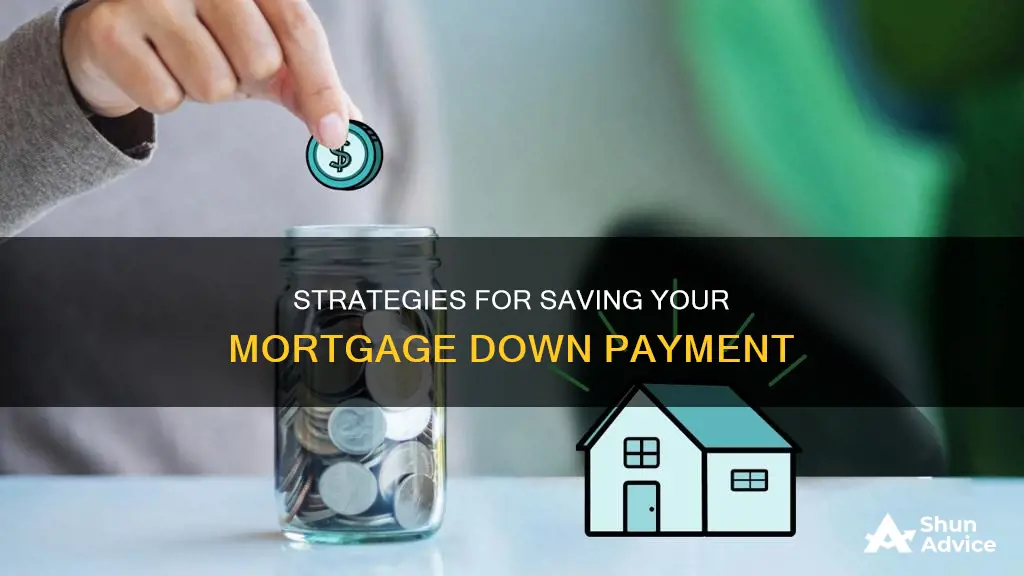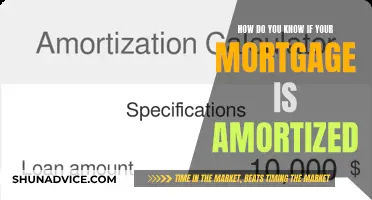
Saving for a mortgage down payment can be a challenging process, especially for first-time homebuyers. The down payment is the cash paid upfront for a large purchase like a home, with the rest of the purchase price paid via a loan. The amount of the down payment can range from 3% to 20% of the home's purchase price, and it is influenced by factors such as the type of mortgage, financial situation, and property type. With rising home prices, saving for a down payment can take several years, and individuals may need to tap into their savings or explore options like low-down-payment loans, bridge loans, or home equity loans.
| Characteristics | Values |
|---|---|
| Down payment amount | Typically a percentage of the home's purchase price, ranging from 3% to 20% for a primary residence |
| Factors influencing down payment amount | Type of mortgage, financial situation, and type of property |
| Benefits of larger down payment | Lower loan amount, potential for a higher-priced home, lower interest rate |
| Challenges of saving for a down payment | Rising rents, increasing home prices, and higher interest rates |
| Low or no-down-payment options | Low- or no-down-payment government-backed mortgage programs, bridge loans, home equity loans, 401(k) loans, borrowing from friends or family |
| Considerations | Private mortgage insurance (PMI) may be required if the down payment is less than 20%, increasing monthly payments |
What You'll Learn

Saving for a down payment
First, it's important to understand that a down payment is a percentage of the purchase price of a home that you pay upfront when taking out a mortgage. The amount can vary, typically ranging from 3% to 20% for a primary residence. The specific percentage depends on factors such as the type of mortgage, your financial situation, and whether it is your primary residence or an investment property. A larger down payment can provide benefits such as a lower interest rate or the ability to purchase a higher-priced home. However, it may take several years to save for a substantial down payment, especially for first-time homebuyers.
To begin saving, assess your financial situation and set a realistic target for the down payment amount. Consider your income, expenses, and any other financial commitments you may have. Create a budget that allows you to allocate a certain amount each month towards your down payment savings. Automate your savings by setting up regular transfers from your paycheck or monthly income to a dedicated savings account. This helps in building your down payment fund consistently over time.
Additionally, explore different savings strategies to boost your savings. Consider opening a matched savings program account, also known as an individual development account. These programs will match the savings you've already accumulated, helping to increase your total down payment faster. Take advantage of tax-advantaged savings accounts, such as retirement accounts, which can provide tax benefits and potentially higher returns on your savings. If you have existing investments or assets, evaluate whether it makes sense to liquidate them to fund your down payment.
Finally, while saving for a down payment, it's crucial to be mindful of your spending habits. Reduce unnecessary expenses and focus on prioritising your savings goal. Cut down on discretionary spending, such as eating out frequently or subscription services you may not fully utilise. Instead, allocate that money towards your down payment fund. It's also beneficial to build an emergency fund alongside your down payment savings to prepare for unexpected expenses. This will ensure that you don't dip into your down payment savings for unforeseen costs.
Wall Street's Mortgage Business: How It Works
You may want to see also

Down payment loans
There are several options for those who need to borrow money for a down payment. Some lenders may allow the use of a personal loan, although this is generally not recommended as it increases the borrower's debt-to-income ratio. A better option may be to take out a loan on a 401(k) retirement plan, allowing borrowers to typically borrow up to 50% of their vested account balance or $50,000, whichever is less. Another option is a first-mortgage bridge loan, which requires taking out a large loan for more than the borrower currently owes, usually up to 80% of the current home's value. The borrower can then use the extra cash as a down payment on the new house. A second-mortgage bridge loan is similar to a home equity loan, where the borrower takes out a loan on a portion of the equity in their existing home to cover the down payment on the new home.
For those who qualify, there are also low- or no-down-payment government-backed mortgage programs. These include VA loans, which are for current and veteran military service members and eligible surviving spouses, and USDA loans, which are for rural and suburban homebuyers who meet the program's income limits and other requirements. FHA loans, backed by the Federal Housing Administration, require a minimum down payment of 3.5% with a credit score of at least 580, or 10% with a credit score between 500 and 579.
While there are options available for those who need to borrow money for a down payment, it is important to carefully consider the financial implications of each choice. Increasing debt can negatively impact the ability to qualify for a loan and may result in higher monthly payments and interest rates.
Hawaii's Mortgage Mystery: How Do Locals Afford It?
You may want to see also

Down payment amount
The amount of money required for a down payment on a house varies depending on several factors. Down payments are usually shown as a percentage of the price of the house. This can range from 3% to 20% for a primary residence. For example, a 10% down payment on a $350,000 home would be $35,000.
The required down payment amount is usually determined by the type of mortgage chosen, the financial situation of the buyer, and the type of property being purchased. A higher down payment reduces the loan-to-value ratio, which may result in the lender waiving the requirement for private mortgage insurance (PMI). This insurance is an additional monthly cost that protects the lender in case the borrower defaults on the loan.
Saving for a down payment can take several years, especially for first-time homebuyers. Low- or no-down-payment loans are available, but these often come with additional costs in the form of fees or mortgage insurance. Bridge loans are another option, allowing borrowers to use the equity in their current home for a new home purchase. Borrowers can also take out a loan against their 401(k) or borrow from friends and family, although lenders will only accept private loans secured by an asset, such as a home, car, or other valuables.
Verifying Primary Residence: What Mortgage Lenders Need to Know
You may want to see also

Lender requirements
Lenders may also impose restrictions on the type of money that can be used for the down payment. They often require borrowers to contribute their own funds, such as savings or investments, towards the down payment. This demonstrates the borrower's financial commitment and stability. It is worth noting that using certain sources of funds, such as loans with deferred payments or matched savings programs, may be acceptable to some lenders, but it is important to carefully review the lender's guidelines.
Additionally, the type of mortgage chosen can impact the required down payment. For example, conventional financing typically requires a 20% down payment. If the borrower opts for a lower down payment, the lender may consider it a higher-risk investment and require private mortgage insurance (PMI) to be purchased. This insurance protects the lender in case of default and results in higher monthly payments for the borrower.
Another factor that influences lender requirements is the borrower's financial situation. Lenders assess factors such as income, credit score, and existing debt to determine the borrower's ability to secure a loan. A stronger financial profile may provide more flexibility in negotiating the down payment amount. It is always advisable to consult with a financial professional to understand the specific requirements and options available based on an individual's financial circumstances.
Understanding Mortgages: A Guide to Home Loans
You may want to see also

Low- or no-down-payment loans
There are several low- or no-down-payment loan options available. The most prominent are the VA and USDA loans. VA loans are backed by the US Department of Veterans Affairs and are available to military service members, veterans, and their surviving spouses. They do not require a down payment and do not charge mortgage insurance, but they do have a funding fee ranging from 1.25% to 3.3% of the loan amount. USDA loans, on the other hand, are offered by the US Department of Agriculture to lower- to moderate-income buyers in eligible rural areas. These loans also do not require a down payment and often have lower mortgage rates compared to similar options. However, they also come with an upfront funding fee and an annual fee included in the monthly mortgage payment.
FHA loans, backed by the Federal Housing Administration, are another option, requiring a down payment of only 3.5% with a credit score as low as 580. Additionally, government-backed programs and grants at the state and federal levels can provide assistance with down payments and closing costs, making homeownership more attainable for those with limited funds. For example, the HomePath Ready Buyer program offers up to 3% in closing cost assistance for eligible buyers purchasing a Fannie Mae-owned property.
Lastly, seller concessions, where the seller agrees to pay a portion or all of the buyer's closing costs, can also reduce the upfront financial burden for the buyer. This is typically negotiated as part of the home purchase agreement and can cover various fees, such as property taxes, attorney fees, and mortgage points.
Cashing Out Refinance Mortgages: Strategies for Homeowners
You may want to see also
Frequently asked questions
A down payment is the cash you pay upfront to make a large purchase, such as a home. Down payments are usually shown as a percentage of the price.
The amount of money you need for a down payment depends on the type of mortgage you plan to apply for, your financial situation, and the type of property you're buying. Down payments can range from 3% to 20% for a primary residence.
Saving enough money for a down payment can take several years, and rising rents and interest rates have made it harder for people to save. Some people use low- or no-down-payment loans, which come with additional fees or mortgage insurance. Others borrow from friends or family, or take out a loan using their vested account balance or home equity.
A larger down payment can help you purchase a higher-priced home or get a lower interest rate. It will also lower your total loan amount, meaning you'll pay less in interest over the life of the loan. A larger down payment may also prevent you from having to pay private mortgage insurance.







